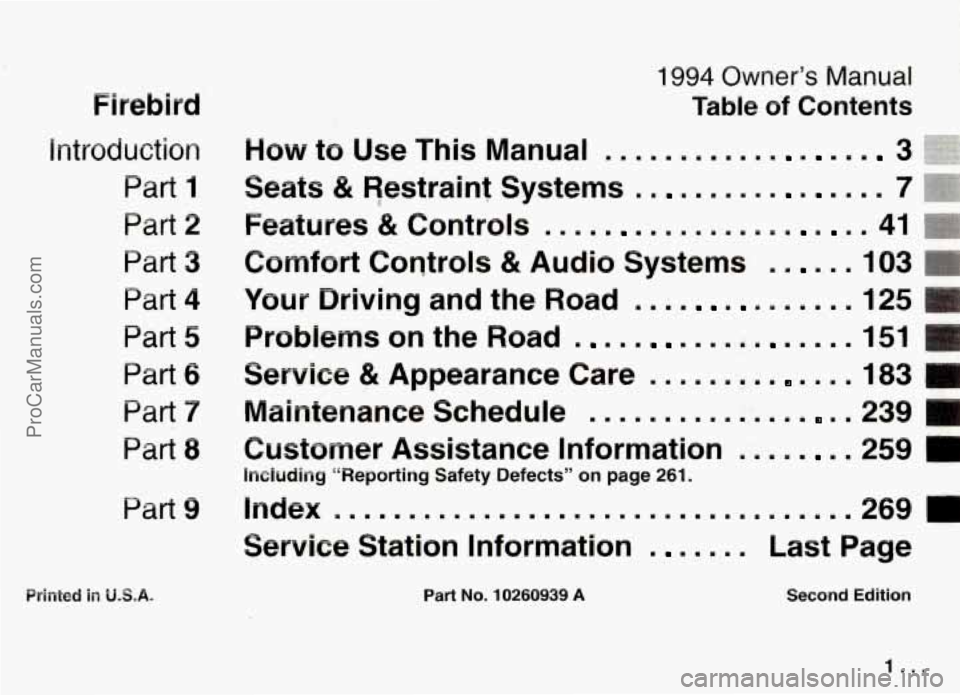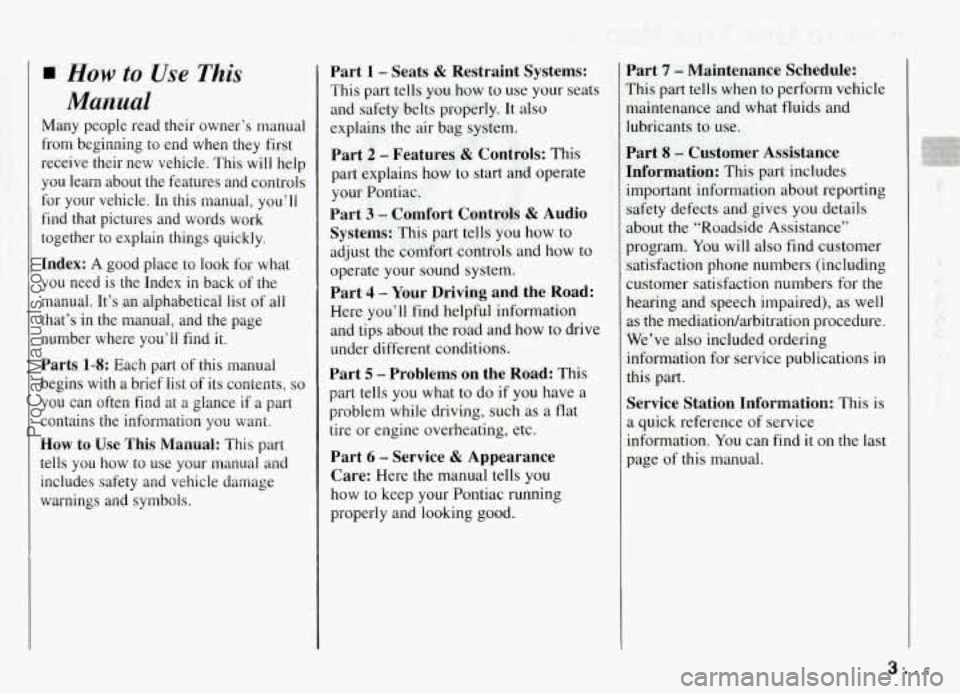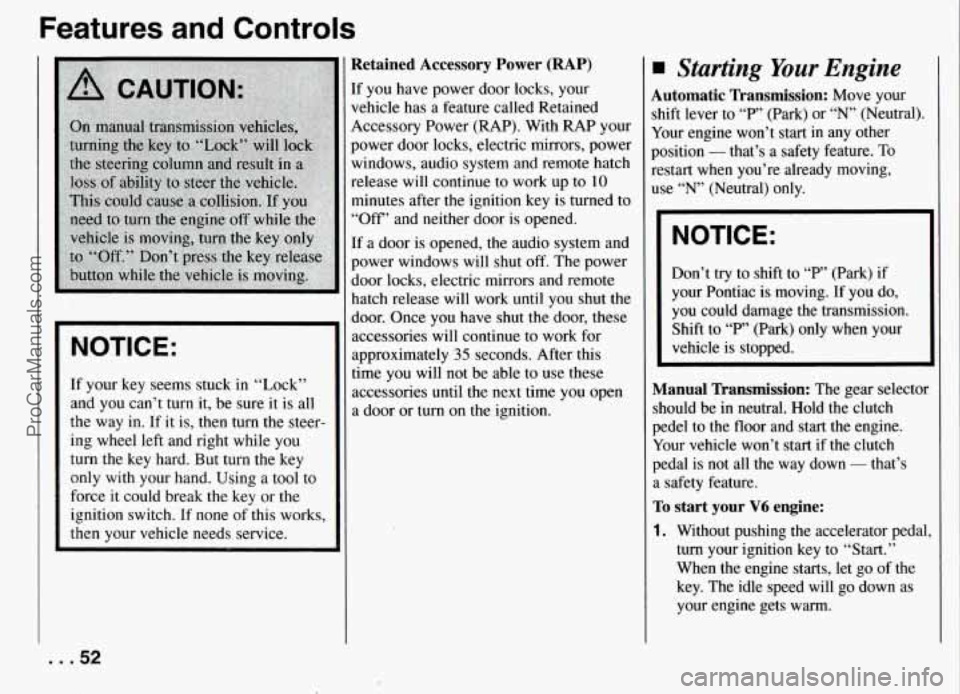audio PONTIAC FIREBIRD 1994 Owners Manual
[x] Cancel search | Manufacturer: PONTIAC, Model Year: 1994, Model line: FIREBIRD, Model: PONTIAC FIREBIRD 1994Pages: 290, PDF Size: 14.84 MB
Page 2 of 290

Firebird
1994 0wn:er’s Manual
Table of Contents
Introduction
Part 1
Part 2
Part 3
Part 4
Part 5
Part 6
Part 9
Part 8
Part 9
How to Use This Manual ,, 3
Seats
& Restraint 6 Systems 7
Features & Controls m 41
Comfort Coqtrols
& Audio Systems 103
Your Driving and the
Road m 125
Probiems
on the Road = 151
& Appearance Care m =. 183
Maintenance Schedule
A = 239
Customer Assistance Information
m 259
Including “Reporting Safety Defects” on page 261.
hdeX smmmm=m.====mmmmm==.mm=mmmmm==m=mmm 269
Servi.ce Station Information
Last Page
Printed in U.S.A. Part No. 10260939 A Second Edition
1 ...
ProCarManuals.com
Page 4 of 290

How to Use This
Manual
Many people read their owner’s manual
from beginning to end when they first
receive their new vehicle. This will help you learn about the features and controls
for your vehicle. In this manual, you’ll
find that pictures and words work
together to explain things quickly.
~ Index: A good place to look for what
you need is the Index
in back of the
manual. It’s an alphabetical list of all
that’s in the manual, and the page
number where you’ll find it.
Parts 1-8: Each part of this manual
begins with a brief list of its contents,
so
you can often find at a glance if a part
contains the information you want.
How to Use This Manual: This part
tells you how to use your manual and
includes safety and vehicle damage
warnings and symbols.
Part 1 - Seats & Restraint Systems:
This part tells you how to use your seats
and safety belts properly.
It also
explains the air bag system.
Part 2 - Features & Controls: This
part explains how to start and operate
your Pontiac.
Part 3 - Comfort Controls & Audio
Systems:
This part tells you how to
adjust the comfort controls and how
to
operate your sound system.
Part 4 - Your Driving and the Road:
Here you’ll find helpful information
and tips about the road and how to drive
under different conditions.
Part 5 - Problems on the Road: This
part tells you what to do if you have a
problem while driving, such as a flat
tire or engine overheating, etc.
Part 6 - Service & Appearance
Care:
Here the manual tells you
how to keep your Pontiac running
properly and looking good.
Part 7 - Maintenance Schedule:
This part tells when to perform vehicle
maintenance and what fluids and
lubricants to use.
Part 8 - Customer Assistance
Information:
This part includes
important information about reporting
safety defects and gives
you details
about the “Roadside Assistance” program.
You will also find customer
satisfaction phone numbers (including
customer satisfaction numbers for the
hearing and speech impaired), as well
as the mediatiodarbitration procedure.
We’ve also included ordering
information for service publications in
this part.
Service Station Information: This is
a quick reference of service
information.
You can find it on the last
page of this manual.
3...
ProCarManuals.com
Page 53 of 290

Features and Controls
If your key seems stuck in “Lock”
and you can’t turn it, be sure it is all
the way in. If
it is, then turn the steer-
ing wheel left and right while you
turn the key hard. But turn the key
only with your hand. Using a tool to
force it could break the key or the
ignition switch.
If none of this works,
then your vehicle needs service.
Retained Accessory Power (RAP)
[f you have power door locks, your
vehicle has a feature called Retained
Accessory Power (RAP). With
RAP your
power door locks, electric mirrors, power
windows, audio system and remote hatch
release will continue to work up to 10
minutes after the ignition key is turned to
“OW’ and neither door is opened.
[f a door is opened, the audio system and
power windows will shut
off. The power
door locks, electric mirrors and remote
hatch release will work until you shut the
door. Once you have shut the door, these
accessories will continue to work for
approximately
35 seconds. After this
time you will not be able to use these
accessories until the next time you open
a door or turn on the ignition.
Starting Your Engine
Automatic Transmission: Move your
shift lever to
“P” (Park) or “N’ (Neutral).
Your engine won’t start in any other
position
- that’s a safety feature. To
restart when you’re already moving,
use
“N’ (Neutral) only.
NOTICE:
Don’t try to shift to “P” (Park) if
your Pontiac is moving. If you do,
you could damage the transmission.
Shift to
“P” (Park) only when your
vehicle is stopped.
Manual Transmission: The gear select01
should be in neutral. Hold the clutch
pede1 to the floor and start the engine.
Your vehicle won’t start if the clutch
pedal is not all the way down
- that’s
a safety feature.
To start your V6 engine:
1. Without pushing the accelerator pedal
turn your ignition key to “Start.”
When the engine starts, let go of the
key. The idle speed will go down as
your engine gets warm.
... 52
ProCarManuals.com
Page 88 of 290

Instrument Panel
1. Fog Lamp Switch (if equipped)
2. Main Light Control
3. Side Upper Air Vent
4. Instrument Cluster
5. Horn
6. Center Upper Air Vent
7. Audio System
8. Glove Box
9. Comfort Controls
10. Cigarette Lighter
11. Parking Brake Lever
12. Cupholder
13. Storage Console and Cassette Tape/
14. Transmission Mode Switch Compact
Disc Storage (as equipped)
(Automatic Transmission)
15. Shift Lever
16. Ashtray (Automatic Transmission)
17. Rear Window Defogger Switch
18. Steering Wheel Controls
19. Remote Hatch Release
20. Convertible Top Switch
21. Traction Control Switch
(if
equipped)
(if equipped)
22. Ashtray (Manual Transmission)
87 ...
ProCarManuals.com
Page 95 of 290

Features and Controls
I
Voltmeter
You can read battery voltage on your
voltmeter.
If it reads less than 11 volts or
more than
16 volts while your engine is
running, and it stays there, you may have
a problem with the electrical charging
system. Have it checked right away.
Driving with the voltmeter reading in a
warning zone could drain your battery.
If you idle your engine for a while, the
voltmeter reading might move into the
yellow zone.
If the reading stays in the
yellow zone while you are driving, you
may have a problem with the electrical
charging system. Have it checked. While
the voltmeter reads in the yellow zone,
your battery may not be able
to power
certain electrical accessories, like
ABS.
... 94
:If this happens, your “ABS INOP’ light
will come on. See “Anti-Lock Brake
System Warning Light” in this
part.)
[f you must drive a short distance with the
voltmeter reading in a warning zone, turn
~ff all your accessories, including your
:omfort control and audio systems.
Malfunction Indicator Lamp
(Service Engine Soon Light)
A computer monitors operation of your
fuel, ignition and emission control
systems. This light should come on when
the ignition is on, but the engine is not
running, as a check to show you it is
working.
If it doesnot come on at all,
have it fixed right away.
If it stays on, or
it comes on while you are driving, the
computer is indicating that you have a
problem. You should take your vehicle in
for service soon.
ProCarManuals.com
Page 104 of 290

Part 3
In this part you’ll find out how
o operate the comfort control
iystems and audio systems
Iffered with your Pontiac
. Be
ure to read about the particular
iystem supplied with your
lehicle
.
Comfort Controls & Audio
Systems
Comfort Controls ................................................ 104
Heater Controls
............................................... 104
Heating
...................................................... 104
Bi-Level Heating
.............................................. 105
Ventilation ................................................... 105
Defogging and Defrosting Windows
............................... 105
Air Conditioner Controls
........................................ 106
Cooling
...................................................... 106
Rear Window Defogger
......................................... 107 __
Flow-Through Ventilation System .................................
Audiosystems ..................................................
107
108
Settingtheclock
.............................................. 109
AMPM Stereo with Cassette Tape Player
........................... 109
AM/FM Stereo with Cassette Tape Player and Graphic Equalizer
........ 112
AM/FM Stereo with Compact Disc Player and Graphic Equalizer
........ 118
AM/FM
Stereo with Compact Disc Player
.......................... 115
Understanding Radio Reception
.................................. 121 .
Care of Your Cassette Tape Player .................................
Care of Your Compact Discs .....................................
FixedMastAntenna ............................................
122
123
123
103 ...
ProCarManuals.com
Page 105 of 290

Comfort Controls and Audio Systems
Comfort Controls
With this system, you can control the
heating and ventilation in your Pontiac. If
you have the air conditioning option, you
can also control cooling.
Your vehicle also has the flow-through
ventilation system described later in this
section.
Heater Controls
Fan Control Knob
8 : Turn this knob to select the force of
air you want.
. .IO4
Temperature Control Knob
Turn the knob to change the temperature
of the air flowing from the heating
system. Turn it to the right for warmer air
and to the left for cooler air. The
temperature of the air can not be less than
the temperature of the outside air.
Air Control Knob
OFF:
The system is off.
2 : Air flows through the upper air
vents.
-3 : Air is directed through the upper air
vents and the heater ducts.
.A : This setting directs most of the air
through the heater ducts and some
of the
air through the windshield defroster vents.
3 : Air is directed through the
windshield defroster vents and the heater
ducts.
9 : This setting directs most of the air
through the windshield defroster vents and some of the air through the heater
ducts.
Heating
The heater works best if you keep your
windows closed while using it.
1. Turn the air control knob to ./J .
2. Turn the fan control knob to the right.
3. Turn the temperature control knob to a
comfortable setting.
ProCarManuals.com
Page 107 of 290

Comfort Controls and Audio Systems
I‘
Air Conditioner Controls (OPTIoN)
The air conditioning system uses the same
controls
as the heating system, except that
the air control knob has two extra
settings, described below. For
an
explanation of all the controls, see
“Heater Controls” earlier in this part.
MAX: Provides maximum cooling or
quick cool-down on very hot days. This
setting recirculates most of the air inside
your vehicle. If it is used for long periods
of time, the air may become
dry. This
setting directs air through the upper air
vents.
. . .lo6
A/C: Use for normal cooling on hot days
This setting cools outside air and directs
through the upper air vents.
The air conditioner comtxessor oDerates
in
“MAX,” “NC” and ii VJ , ,% and
9 when the outside temperature is
a6&e freezing. When the air conditioner
is on, you may sometimes notice slight
changes in your vehicle’s engine speed
and power. This is normal because the
system is designed
to cycle the
compressor on and
off to keep the desirec
cooling and help fuel economy.
Cooling
The air conditioner works best
if you keep
your windows closed. On very hot days,
open the windows just long enough for
the hot air to escape.
1. Turn the air control knob to “NC” for
normal cooling. For faster cooling
move the knob to
‘“AX.”
2. Turn the temperature control knob to
3. Turn the fan control knob to the right. a comfortable setting.
ProCarManuals.com
Page 109 of 290

Comfort Controls and Audio Systems
/I
Ventilation Tips
Keep the hood and front air inlet free
of ice, snow, or any other obstruction
(such as leaves). The heater and
defroster will work far better, reducin
the chance of fogging the inside of
your windows.
When you enter a vehicle
in cold
weather, turn the fan control knob to
the right for a few moments before
driving off. This helps clear the intak
ducts of snow and moisture, and
reduces the chance of fogging the
inside
of your windows.
Keep the air path under the front seat
clear of objects. This helps air to
circulate throughout your vehicle.
Audio Systems
7
i
(
1:
1
1
i
1
1
I
I’
four Delco@ audio system has been
lesigned to operate easily and give years
>f listening pleasure. But you will get the
nost enjoyment out of it if you acquaint
yourself with it first..Find out what your
Delco’ system can do and how to operate
111 its controls, to be sure you’re getting
he most out of the advanced engineering
:hat went into it.
[f you have power door locks, your
vehicle has a feature called Retained
Accessory Power
(RAP). With RAP you
:an play your audio system even after the
ignition is
off. See the Index under
“Retained Accessory Power.”
NOTICE:
Before you add any sound equipment
to your vehicle
- like a tape player,
CB radio, mobile telephone or
two-way radio
- be sure you can
add what you want. If you
can, it’s
very important to do it properly.
Added sound equipment may inter-
fere with the operation of your
vehicle’s engine, Delco@ radio or
other systems, and even damage them. And, your vehicle’s systems
may interfere with the operation of
sound equipment that has been added
improperly
So, before adding sound equipment,
check with your dealer and be sure to
check Federal rules covering mobile radio and telephone units.
. . .IO8
ProCarManuals.com
Page 111 of 290

Comfort Controls and Audio Systems
Pushbuttons
The six pushbuttons let you return to
your favorite stations. You can preset
up to 18 stations
(6 AM, 6 FMl and
6 FM2).
1. Press “AM/FM’ to choose AM,
2. Tune in the station.
FM1 or
FM2.
3. Press and hold one of the six
pushbuttons until the display shows
“SET.” Whenever you press that
button, the preset station will
return.
Repeat these steps for each pushbutton.
Steering Wheel Controls
Your vehicle may be equipped with
steering wheel controls for this audio
system. With steering wheel controls,
you can use the buttons
on your
steering wheel to:
Turn the audio system on or off.
Adjust the volume.
Choose AM, FM1 or FM2.
Use the seek and recall functions.
Choose one of the preset stations
on your pushbuttons.
Setting the Tone
Bass:
Slide the “BASS” lever to the
5ght to hear more bass.
I’reble: Slide the “TREBLE’ lever to
:he right to hear more treble.
[f a station is weak and noisy, slide
‘TREBLE’ to the left to reduce the
noise.
Adjusting the Speakers
Balance:
Press “BAL” to release the
knob. Turn the knob to move the sound
between the right and left speakers.
Push “BAL” back in to store
it when
not adjusting.
Fade: Press “FADE” to release the
knob. Turn the knob to move the sound
between the front and rear speakers.
Push “FADE’ back in to store it when
not adjusting.
To Play a Cassette Tape
Your tape player is built to work best
with tapes that are
30 to 45 minutes
long on each side. Tapes longer than
that are
so thin they may not work well
in this player. A cassette symbol will
appear in the upper left corner of the
display whenever a tape is inserted.
The longer side with the tape visible
goes in first. If you hear nothing or
hear just a garbled sound, it may not be
in squarely. Press “EJECT” to remove
the tape and start over.
Once the tape is playing, use “VOLUME,” “FADE,” “TREBLE’
and “BASS” just as you do for the
radio. The arrows show which side of
the tape is playing.
Forward
Press “FWD” to rapidly advance to
another part of the tape. Press “PROG”
or “FWD” again to stop it. The radio will play during this operation.
. . .I10
ProCarManuals.com